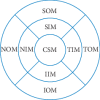Analysis of Peripapillary and Macular Choroidal Thickness in Eyes with Pseudoexfoliative Glaucoma and Fellow Eyes
- PMID: 32587764
- PMCID: PMC7298271
- DOI: 10.1155/2020/9634543
Analysis of Peripapillary and Macular Choroidal Thickness in Eyes with Pseudoexfoliative Glaucoma and Fellow Eyes
Abstract
Purpose: To compare differences in peripapillary and macular choroidal thickness in pseudoexfoliative glaucoma (PXG) eyes, nonexfoliative fellow eyes, and normal eyes.
Methods: This case-control study included 37 PXG patients (group A: 37 PXG eyes; group B: 37 nonexfoliative fellow eyes) and 37 sex-, age-, and axial length-matched healthy volunteer eyes (group C). Peripapillary and macular choroidal thickness and volume were measured in all subjects via enhanced-depth imaging-optical coherence tomography.
Results: The average peripapillary (AP) choroidal thickness was (130.10 ± 46.14) μm, (131.43 ± 46.00) μm, and (147.89 ± 53.32) μm; average macular (AM) choroidal thickness was (191.72 ± 68.07) μm, (204.62 ± 69.54) μm, and (215.10 ± 45.40) μm; and average volume was (0.59 ± 0.21) μm3, (0.63 ± 0.21) μm3, and (0.65 ± 0.14) μm3 in groups A, B, and C, respectively. NIP choroidal thickness was significantly lower in groups A and B than in group C (P < 0.05). TIM and TOM choroidal thickness and volume were significantly lower in group A than in group C (P < 0.05). NIM, SIM, NOM, IOM, AM choroidal thickness and volume, and CSM choroidal thickness were significantly lower in group A than in group B (P < 0.05). CSM, TIM, and TOM in group A and TIM, TOM choroidal thickness, and volume in group B were significantly lower than in group C (P < 0.05).
Conclusions: NIP choroidal thickness in PXG eyes and nonexfoliative fellow eyes and temporal macular choroidal thickness in PXG eyes were significantly lower than in normal eyes. Macular choroidal thickness (except in temporal regions) was significantly lower in PXG eyes than in nonexfoliative fellow eyes. Changes in peripapillary and macula choroidal thickness further elucidate the choroid's role in PXG development and progression.
Copyright © 2020 Fan Li et al.
Conflict of interest statement
The authors declare that there are no conflicts of interest.
Figures




Similar articles
-
Clinical Analysis of Macular Choroidal Thickness in Pseudoexfoliative Glaucoma and Primary Open-Angle Glaucoma.J Ophthalmol. 2021 Nov 16;2021:3897952. doi: 10.1155/2021/3897952. eCollection 2021. J Ophthalmol. 2021. PMID: 34824868 Free PMC article.
-
Comparison of Macular Choroidal Thickness and Volume between Pseudoexfoliative Glaucoma and Pseudoexfoliative Syndrome.J Ophthalmol. 2020 Nov 26;2020:8886398. doi: 10.1155/2020/8886398. eCollection 2020. J Ophthalmol. 2020. PMID: 33884201 Free PMC article.
-
Clinical observation of macular choroidal thickness in primary chronic angle-closure glaucoma.Int Ophthalmol. 2021 Dec;41(12):4217-4223. doi: 10.1007/s10792-021-01988-7. Epub 2021 Jul 31. Int Ophthalmol. 2021. PMID: 34333686 Review.
-
Analysis of the choroidal vascularity in asymmetric pseudoexfoliative glaucoma using optical coherence tomography-based image binarization.Eye (Lond). 2022 Aug;36(8):1615-1622. doi: 10.1038/s41433-021-01700-0. Epub 2021 Jul 23. Eye (Lond). 2022. PMID: 34302135 Free PMC article.
-
The Role of Vessel Density as Measured by Optical Coherence Tomography Angiography in the Evaluation of Pseudoexfoliative Glaucoma: A Review of the Literature.Ophthalmol Ther. 2022 Apr;11(2):533-545. doi: 10.1007/s40123-022-00483-1. Epub 2022 Feb 24. Ophthalmol Ther. 2022. PMID: 35211880 Free PMC article. Review.
Cited by
-
The impact of horizontal eye movements versus intraocular pressure on optic nerve head biomechanics: A tridimensional finite element analysis study.Heliyon. 2023 Feb 11;9(2):e13634. doi: 10.1016/j.heliyon.2023.e13634. eCollection 2023 Feb. Heliyon. 2023. PMID: 36865452 Free PMC article.
-
Clinical Analysis of Macular Choroidal Thickness in Pseudoexfoliative Glaucoma and Primary Open-Angle Glaucoma.J Ophthalmol. 2021 Nov 16;2021:3897952. doi: 10.1155/2021/3897952. eCollection 2021. J Ophthalmol. 2021. PMID: 34824868 Free PMC article.
-
Morphological characteristics of the subfoveal choroid and their association with visual acuity in postoperative patients with unilateral congenital cataracts.Ann Transl Med. 2022 Jul;10(13):726. doi: 10.21037/atm-22-1155. Ann Transl Med. 2022. PMID: 35957713 Free PMC article.
References
-
- Streeten B. W. Pseudoexfoliative fibrillopathy in visceral organs of a patient with pseudoexfoliation syndrome. Archives of Ophthalmology. 1992;110(12):1757–1762. - PubMed
-
- Schlötzer-Schrehardt U., Küchle M., Naumann G. O. Electron-microscopic identification of pseudoexfoliation material in extrabulbar tissue. Archives of Ophthalmology. 1991;109(4):p. 565. - PubMed
LinkOut - more resources
Full Text Sources

